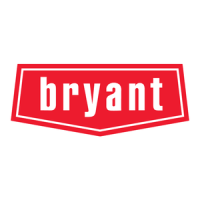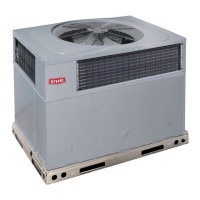For longer life, operating economy, and continuing efficiency,
clean accumulated dirt and grease from the blower wheel and
motor annually.
WARNING: Disconnect and tag electrical power to the
unit before cleaning and lubricating the blower motor and
wheel. Failure to adhere to this warning could cause
serious injury or death.
III. OUTDOOR COIL, INDOOR COIL, AND
CONDENSATE DRAIN PAN
Inspect the condenser coil, evaporator coil, and condensate drain
pan at least once each heating and cooling season or sooner if
conditions require.
The coils are easily cleaned when dry; therefore, inspect and clean
the coils either before or after each cooling season. Remove all
obstructions, including weeds and shrubs, that interfere with the
airflow through the condenser coil.
Straighten bent fins with a fin comb. If coated with dirt or lint,
clean the coils with a vacuum cleaner, using the soft brush
attachment. Be careful not to bend the fins. If coated with oil or
grease, clean the coils with a mild detergent-and-water solution.
Rinse coils with clear water, using a garden hose. Be careful not to
splash water on motors, insulation, wiring, or air filter(s). For best
results, spray condenser coil fins from inside to outside the unit.
On units with an outer and inner condenser coil, be sure to clean
between the coils. Be sure to flush all dirt and debris from the unit
base.
Inspect the drain pan and condensate drain line when inspecting
the coils. Clean the drain pan and condensate drain by removing all
foreign matter from the pan. Flush the pan and drain trough with
clear water. Do not splash water on the insulation, motor, wiring,
or air filter(s). If the drain trough is restricted, clear it with a
“plumbers snake” or similar probe device. Ensure that the auxiliary
drain port above the drain trough is also clear.
IV. OUTDOOR FAN
CAUTION: Keep the condenser fan free from all ob-
structions to ensure proper cooling operation. Never place
articles on top of the unit. Damage to unit may result.
1. Inspect the fan blades for cracks or bends.
2. If fan needs to be removed, remove screws holding outdoor
air intake grille and remove grille.
3. Loosen the setscrew and slide the fan off the motor shaft.
4. When replacing fan blade, position blade so that the hub is
1/8 in. (See Fig. 19) away from the motor end (1/8 in. of
motor shaft will be visible) .
TABLE 7—WET COIL AIR DELIVERY
UNIT 601A 030-060 (DEDUCT 10 PERCENT FOR 208-V)*
UNIT
MOTOR
SPEED
EXTERNAL STATIC PRESSURE (IN. WG)
0.0 0.1 0.2 0.3 0.4 0.5 0.6 0.7 0.8 0.9 1.0
30
Low
Watts295292289--------
Cfm928882802--------
Med
Watts388383377372366361-----
Cfm 1203 1120 1062 1004 930 838 -----
High
Watts----469458449442---
Cfm----1141 1027 924 828 - - -
36
Low
Watts 592 581 567 552 538 525 512 499 - - -
Cfm 1499 1421 1351 1281 1207 1125 1034 936 - - -
Med
Watts - - - 660 636 617 603 592 581 566 -
Cfm - - - 1475 1371 1274 1186 1105 1024 928 -
High
Watts-----776761744725706689
Cfm-----1452 1356 1254 1145 1030 910
42
Low
Watts 606 596 586 575 563 550 537 - - - -
Cfm 1464 1399 1341 1282 1218 1146 1066 - - - -
Med
Watts 680 665 649 635 622 611 600 590 - - -
Cfm 1608 1535 1461 1387 1316 1247 1180 1111 - - -
High
Watts 768 755 742 730 718 707 696 684 671 - -
Cfm 1656 1576 1508 1447 1390 1331 1268 1198 1119 - -
48
Low
Watts 741 724 709 690 664 631 594 562 552 543 -
Cfm 1994 1937 1869 1797 1722 1645 1566 1480 1384 1269 -
Med
Watts - - - 773 744 715 687 662 640 625 -
Cfm - - - 1957 1867 1787 1719 1653 1575 1463 -
High
Watts-----799782773756704-
Cfm-----1914 1842 1774 1686 1538 -
60
Low
Watts 742 723 698 666 629 591 559 540 - - -
Cfm 2197 2141 2103 2057 1988 1894 1783 1674 - - -
Med
Watts 838 822 803 780 752 721 689 661 639 632 -
Cfm 2485 2406 2269 2127 2012 1937 1894 1855 1770 1571 -
High
Watts - 934 913 891 866 837 806 776 750 735 -
Cfm - 2483 2391 2283 2170 2061 1960 1868 1780 1687 -
* Air delivery values are based on operating voltage of 230-v or 460-v, wet coil, without filter or electric heater. Deduct filter and electric heater pressure drops to obtain static
pressure available for ducting.
NOTES:
1. Do not operate the unit at a cooling airflow that is less than 350 cfm for each 12,000 Btuh of rated cooling capacity. Evaporator coil frosting may occur at airflows below
this point.
2. Dashes indicate portions of table that are beyond the blower motor capacity or are not recommended.
3. Deduct 10 percent for 208-v.
—19—

